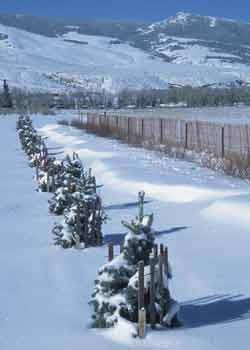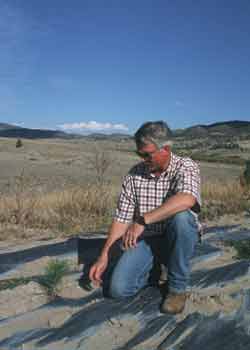Windbreaks
Windbreaks and living snow fences are linear plantings of single or multiple rows of trees or shrubs for the purpose of wind reduction. Proper planning of windbreaks and living snow fences is essential for successful results.
The following are a few considerations:
Location
 Three year old living snow fence. |
- Orient windbreaks and living snow fences perpendicular to the prevailing or snow-bearing winds. In Colorado, generally the prevailing winds blow from the northwest. If this is the case on your property, you would plant trees and shrubs on the north and west sides of the area to be protected.
- To provide adequate protection from wind and snow drifts around buildings, etc., a minimum of 2 to 3 rows is recommended, of which the windward row should be shrubs or short dense tree species.
- Due to the shifting nature of wind, extend the rows a minimum of 150 feet past the edge of the area needing protection.
- The leeward side of a windbreak is protected 10 times the design height, while the windward side is protected 2 times the design height.
- Avoid planting trees or shrubs where they will interfere with structures above and below ground.
- On the windward side of a road in areas having heavy snow accumulation, trees should not be planted closer than 200 feet from the centerline of the road to provide adequate snow storage off the road.
- Ensure that drainage of snowmelt from the windbreak does not flow across livestock areas or manure storage areas.
- Where water erosion is a concern, orient trees or shrubs on or near the contour.
Site Preparation
- Prepare a 3 foot diameter circle for each tree or shrub by mechanically, manually, or chemically removing all weeds and sod. This will reduce water and nutrient competition.
Planting
- Plant while local trees are dormant, in the fall, late winter, or spring.
- Use a tree bar, shovel, auger, or tree planter.
- Planting holes or furrows must be deep enough so that the roots are not curled or crowded. If holes are augered, break up the compacted layer caused by the auger along the edge of the hole.
- Soil must be gently but firmly compacted to remove air pockets in the soil. Watering after planting helps remove air pockets as well.
 Plastic can be used for weed control and water conservation. |
Water
- Unless natural precipitation is adequate, supplemental water will be needed during plant establishment. Use drip irrigation, flood irrigation, or hand water for supplemental watering.
- To maximize available water in the soil, water the seedlings after planting.
- Mulch material such as wood chips or fabricated plastic mulches may be used for water collection/conservation and weed control around the plants.
Animal Protection
- Keep livestock fenced out of the planting area.
- Use rabbit guards and/or tree shelters to protect from wildlife damage.
- Check trees often for signs of rodent damage at the soil surface.
Plant Species Selection
- For successful plantings, consider the soil type and annual precipitation when choosing plant species. To determine the soil type on your property, visit the NRCS web soil survey. Click on start WSS and navigate by your address.
- Learn more about species recommendations, Planning and Planting a Windbreak.
Resources
Resources & Helpful Information
SAM Webinars and Web Videos
SAM Newsletter Articles
More Information
-
-
- NRCS Windbreak Info – how windbreaks work, windbreak establishment, management, windbreaks for rural living, windbreaks for snow management, etc.
- Tree Seedling Sale – CO State Forest Service Seedling Tree Nursery, pick-up at Fort Collins or from your local Conservation Service
-




